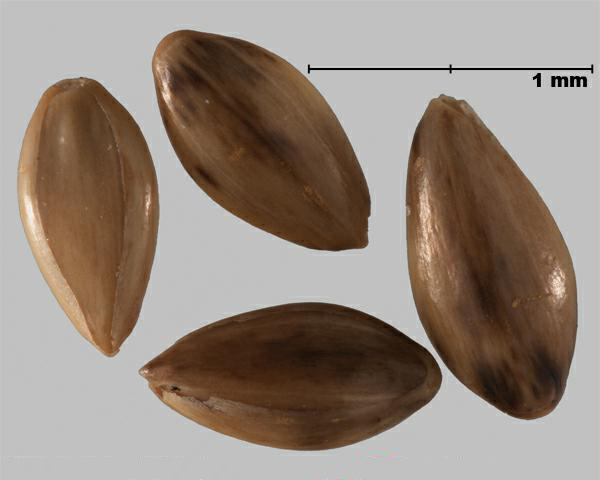Family
Poaceae
Common Name
Panic grass
Regulation
Secondary Noxious, Class 4 and Noxious, Class 5 in the Canadian Weed Seeds Order, 2016 under the Seeds Act.
Distribution
Canadian: The genus includes 6 species found in Canada, distributed across Canada with the exception of NL, NU and YT (Brouillet et al. 2016Footnote 1).
Worldwide: Panicum is a large genus of 300 to 600 species originating from tropical and warm temperate parts of the world (Mabberley 2008Footnote 2, eFloras 2016Footnote 3). Its numbers are difficult to estimate because its limits are not clear (Barkworth et al. 2003Footnote 4). Panicum includes a number of weedy species as well as species cultivated as fodders, grains and ornamentals (Mabberley 2008Footnote 2).
Duration of life cycle
Most are annual species
Seed or fruit type
Floret
Identification features
Size
- Florets of Panicum spp. are generally smaller than most Poaceae genera
- Florets of weed Panicum spp. vary from 1.5 - 2.5 mm long; crop Panicum spp. vary from 2.5 - 3.5 mm long
Shape
- Florets of Panicum spp. are oval-shaped, not elongate as other genera
Surface Texture
- Florets of Panicum spp. have a smooth and glossy surface
- The florets are hardened and shell-like, not leathery or papery as other Poaceae genera
Colour
- Florets of weed Panicum spp. are greenish-brown with, pale ends and several pale, longitudinal lines on lemma
- Florets of crop Panicum spp. are solid straw-yellow or orange
Other Features
- Callus at base of floret is bow-shaped and can be straw yellow, brown or black
- Panicum spp. florets do not have rachillas or pedicels, and the palea lacks conspicuous teeth
- Panicum spp. may be found as spikelets; the glumes cover the floret and are papery, straw yellow with raised lines
Habitat and Crop Association
Cultivated fields, old fields, pastures, prairies, shores, floodplains, marshes, swamps, ditches, shallow water, dunes, forest edges, forest clearings, open forests, orchards, vineyards, roadsides, railway lines and disturbed areas (Barkworth et al. 2003Footnote 4, Darbyshire 2003Footnote 5, DiTomaso and Healy 2007Footnote 6). Witch grass (Panicum capillare) commonly infests corn, soybeans, winter wheat and sorghum, and can also infest grasslands (Clements et al. 2004Footnote 7).
General Information
Of the six species occurring in Canada, four are native and two are introduced (Brouillet et al. 2016Footnote 1). Most species occur as weeds of agricultural habitats (Darbyshire 2003Footnote 5, Clements et al. 2004Footnote 7). Witch grass (Panicum capillare), a native species, is the most commonly found in cultivated fields and gardens (Frankton and Mulligan 1993Footnote 8).
Switch grass (Panicum virgatum) and proso millet (Panicum miliaceum) are cultivated for seed and forage, and the latter has a weedy form that is common and competitive in corn fields in Canada (Royer and Dickinson 1999Footnote 9, Darbyshire 2003Footnote 5).
Similar species
Genera from the same tribe as Panicum spp., Paniceae, have features that distinguish them from other grass tribes such as:
- Shed as a spikelet
- Spikelets have papery, unequal glumes, a papery sterile floret and a hard, shell-like or leathery fertile floret.
- Florets lack a rachilla or pedicels
- Inconspicuous palea teeth
- Florets tend to be short oval rather than elongate
Within the Paniceae Tribe, Panicum spp. can be distinguished by:
- Smooth, glossy floret surface
- Bow-shaped callus
- Several pale, longitudinal lines on the lemma of weed Panicum spp.
Photos






